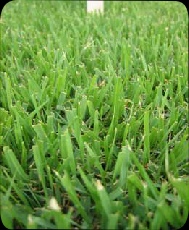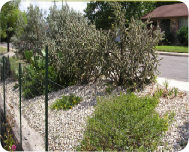



Xeroscape landscaping is a term coined in Denver, Colorado in 1978 and is a landscaping strategy that conserves water by utilizing smart landscape design and selection of plants that are well adapted for the environment they are being placed.
There are seven basic steps that are widely accepted strategies:
1. Planning and design
2. Soil Analysis and preparation
3. Selection of practical turf
4. Selection of appropriate plants, shrubs and trees
5. Efficient irrigation systems
6. Appropriate mulches
7. Appropriate maintenance and care
Planning and Design
A good thought out plan goes a long way. You must consider what you yard can support and not exceed it. Think of landscape budget, appearance, function, maintenance and water requirements. It would be to your best interest to contact a local landscape architect, designer, nurseryman or county extension agent to assist you with your design and planning.
Soil analysis and preparation
Know what kind of soil you have available. In order to ensure healthy vegetation and conserve water, add organic matter to the soil. This will increase the soil ability to absorb and store water in a form available to the vegetation.
Turf Selection
Grasses often require more water than traditional plants like shrubs and trees. Selection of turf must be done in accordance with what grasses are adapted to the environment you are planting them in. Planting the right type of grass for you area is the most effective way to reduce water consumption. In Texas, St. Augistingrass, and bermudergrass are most widely used, but they consume large amounts of water to sustain them. Consider using more adaptable grasses such as Zoysiagrass, Buffalograss and centipedegrass.
Plants, Shrubs, and Trees
Selection of adequate plants, shrubs and trees are important for water conservation and reduced maintenance. As with grasses, some vegetation is ideally suited for specific environments.
Irrigation
There are three types of irrigation systems. 1) Natural, 2) Sprinkler, 3)Drip. The primary goal of a irrigation system is to water the vegetation with the exact amount they require without any waste. Sprinkler irrigation is the most common method of watering in Texas and come in two forms-
Mulches
Mulch is a layer of nonliving material covering the soil surface around plants. Mulches can be organic materials such as pine bark, compost and woodchips; or inorganic materials, such as lava rock, limestone or permeable plastic, not sheet plastic. Use a mulch wherever possible. A good mulch conserves water by significantly reducing moisture evaporation from the soil. Mulch also reduces weed populations, prevents soil compaction and keeps soil temperatures more moderate.
Maintenance and care
While installing this type of landscaping scheme is time consuming up front, it greatly reduces the maintenance load after installation. With proper maintained and care a xeroscape lawn will require less attention than a tradition lawn.

.jpg)


Example of good exroscape landscaping design. Native, drought resistant plants embedded into a rock garden.
A Texas Tech University research team has scientifically characterized a new variety of hardy, drought-
In drought prone areas of Texas, it has been ever increasingly important to reduce the amount of water wasted during it use. Landscaping is sometimes is sacrificed to ensure a community has drinking water. By using a xeroscape design scheme and water collected from a gray water system, landscaping should never go without.
